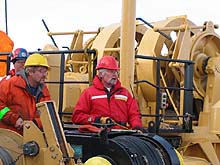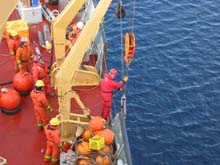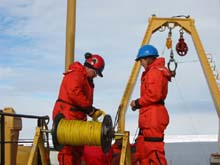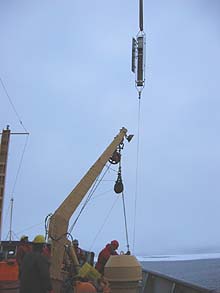
Senior mooring technician Doug Sieberg, crew member Chris Lawrence and Dave Huntley feed the Vectran mooring line over the winch. (Photo courtesy of Dave Allen, University of Washington.) Click image for larger view.
A Mooring Day
August 21, 2002
Louise Timmermans
Institute for Ocean Sciences & University of Victoria, BC, Canada
Today, we placed a mooring. We placed a 3083-m vertical string of six internally-logging instruments and a total of 52 separate components in one of the deepest parts of the Canada Basin. The string is equipped with floatation devices at six levels to keep it vertical once it is anchored on the bottom. We’d like to leave it anchored for the next two years.
We began our day by hanging a 1500 lb clump of chain from the side of the ship and slowly lowering it. Senior mooring technician Doug Sieberg, technician Dave Huntley, scientist Helen Johnson, and the crew and officers of the Louis S. St. Laurent added pieces for the next 13 hours. I was on the bridge, recording the times of water entry of each instrument, ship positions and depths. Our mooring is designed for recovery via aircraft from the ice surface in the Spring. To this end, the weight and bulk of the components have been kept to a minimum. We used very light 3/16” (5 mm) Vectran 12-strand line to separate the components. From my view on the bridge, this looked like dental floss—dental floss that breaks at a load of 4750 lb.

Doug Sieberg lowers the mooring instruments over the side of the Louis. (Photo courtesy of Dave Allen, University of Washington.) Click image for larger view.
The primary purpose of the mooring is to establish a long-term monitoring site in a region of heavy ice to investigate the impacts of global climate change on sea ice. The two shallowest instruments on the mooring will measure the depth of the ice below the sea surface, including how fast the floes are sweeping across the surface.
The shallowest instrument is an ice profiling sonar (IPS), which is a self-contained instrument that measures and records the underwater depth of floating ice moving through its field of view. It is deployed about 50 meters below the surface and faces upward. It transmits an acoustic pulse and then listens for an echo from the bottom of the ice. The IPS examines the returned signals and determines when the signal is returned from the bottom of the sea ice, or, in the absence of ice, from the sea surface. About 50 metres below the IPS is an instrument called an acoustic doppler current profiler (ADCP), which measures the speed of the overlying water (and ice) based on delays in the response times of signals that it emits.
In addition to the instruments deployed on the mooring to monitor ice, we have placed a sonic current meter at about 500 m depth to measure flow speeds and direction, salt content, and temperature in the intermediate depth waters. This component of the mooring belongs to a Japanese oceanographic institute (JAMSTEC, Tokyo). Finally, as part of a continuing investigation of the very deepest waters, Chris Garrett (University of Victoria, BC) , Eddy Carmack (IOS), Humfrey Melling (IOS) and I have placed instruments on the mooring that will record tiny changes in deep-water temperature.
For measuring the deep water temperatures, we have deployed two small, self-contained submersible temperature recorders, as well as "Big Boy”—a 16-channel self-contained data logger designed by Richard Branker Research Ltd. (Ottawa, Canada). It operates with 16 temperature probes (thermistors) on a 160-metre cable that looks like an electrical cord with lumps (the thermistors) on it every 10 metres. All the temperature probes have been designed specifically for this project to be capable of measuring minute (millidegree) changes in temperature and to be very stable over several years.
Each logger can collect up to 600,000 temperature measurements. They will take one temperature reading every half hour for the next two years. Clad in titanium cases, they can withstand the pressures 3000 m below the surface. The thermistor chain spans the interface marking the top of the abyssal water and it is centred at about 2500 m.
Why Record Temperature Changes
Of all the Arctic Ocean basins, the Canada Basin has the largest volume and contains the oldest water believed to have been isolated from the sea surface for about 500 years. It has a total depth of about 4000 m (two and a half miles). It is believed that the very deepest water (deeper than 2400 m) is the relic of a deep-water renewal event (or flushing of the basin) that occurred about 500 years ago. If this is the case, the cause remains a mystery. An alternative hypothesis is that the deep waters are being renewed continuously, albeit very slowly, by dense waters that are produced when ice forms, and are flowing off the continental shelves and down to great depths. Whatever the case, changes in the global climate that affect the shallower parts of the ocean may lead to changes in the deep Arctic Ocean, which could then have a strong effect in shallower waters.
Furthermore, because the deep water is isolated from the rest of the Canada Basin and has an average age of about 500 years, it is possible to detect the effects of geothermal heating from the seafloor. The very bottom layer of water, which is up to 1000 m thick, is completely mixed, likely by convection from this heating. Small changes in temperature of this well-mixed layer will tell us, for example, how long this heating has been taking place (e.g., how long the water has been in isolation) and whether the geothermal heat is remaining in the deep layer or escaping through the top. Our preliminary temperature measurements over the past 10 years indicate that most of the heat input is indeed escaping. We’d like to find out how and where.
Above the bottom layer, our sparse measurements from previous Arctic expeditions indicate a striking “staircase” structure (about 300 m thick) in which there are well-mixed layers of water, or steps. Each step is about 40 m thick and differs by only a few millidegrees in temperature from the next. We know from past laboratory and theoretical studies that this unique staircase structure probably results from the vertical heat transport in seawater. Its density depends on both its salt content and temperature. We call this process double-diffusive convection.
The persistence of the staircase over more than a decade and its coherence for more than 1000 km across the Canada Basin not only indicates geothermal heating but also suggests very little motion at these depths. An interesting feature of the basin is that the well-formed staircase structure is not observed near the edges of the deep basin. This is likely a sign of more mixing and more vertical transport of heat. We hope that the precise instruments on our mooring that will provide us with continuous readings of temperature in the bottom and staircase layers will give us more clues.
With this data we hope to find out how and where the geothermal heat is escaping. How long has this water been in isolation? How did it get there and where did it come from? Are the structures we observe likely to change significantly in the near future? What are the remarkable physical processes that are occurring at these depths? Answers to these questions will further our understanding of the role of the deep water and its relationship to the shallow and intermediate depth waters of the Arctic Ocean, which, as we already know, play a vital part in the global ocean and climate system.
Sign up for the Ocean Explorer E-mail Update List.




























